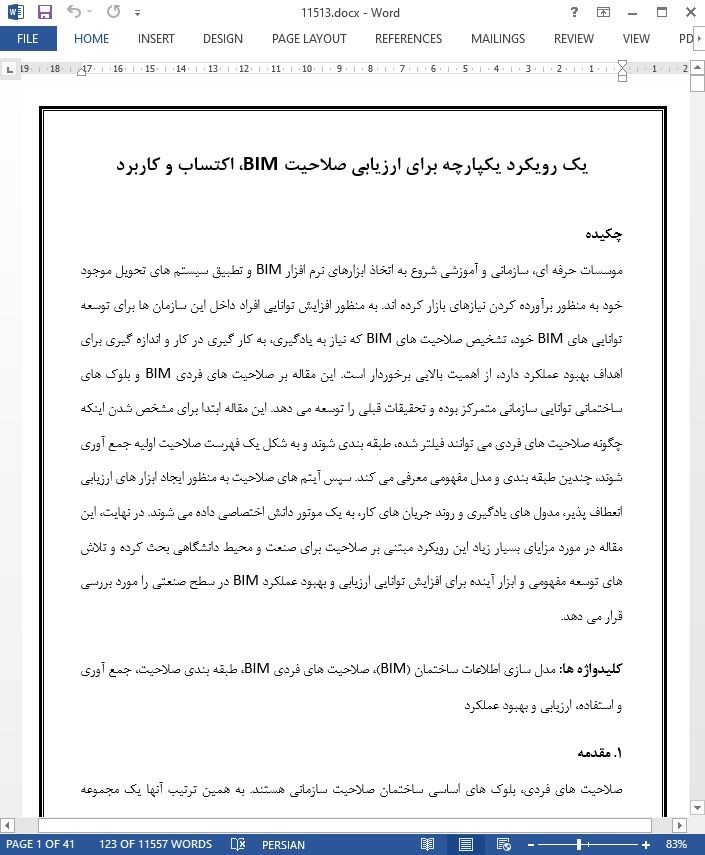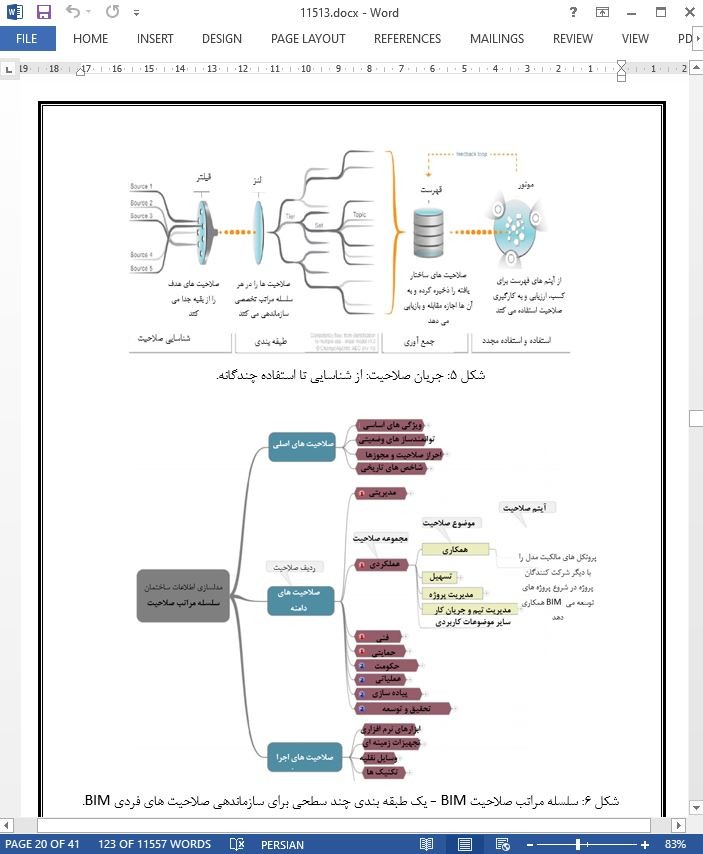
یک رویکرد یکپارچه برای ارزیابی صلاحیت BIM، اکتساب و کاربرد
چکیده
موسسات حرفه ای، سازمانی و آموزشی شروع به اتخاذ ابزارهای نرم افزار BIM و تطبیق سیستم های تحویل موجود خود به منظور برآورده کردن نیازهای بازار کرده اند. به منظور افزایش توانایی افراد داخل این سازمان ها برای توسعه توانایی های BIM خود، تشخیص صلاحیت های BIM که نیاز به یادگیری، به کار گیری در کار و اندازه گیری برای اهداف بهبود عملکرد دارد، از اهمیت بالایی برخوردار است. این مقاله بر صلاحیت های فردی BIM و بلوک های ساختمانی توانایی سازمانی متمرکز بوده و تحقیقات قبلی را توسعه می دهد. این مقاله ابتدا برای مشخص شدن اینکه چگونه صلاحیت های فردی می توانند فیلتر شده، طبقه بندی شوند و به شکل یک فهرست صلاحیت اولیه جمع آوری شوند، چندین طبقه بندی و مدل مفهومی معرفی می کند. سپس آیتم های صلاحیت به منظور ایجاد ابزار های ارزیابی انعطاف پذیر، مدول های یادگیری و روند جریان های کار، به یک موتور دانش اختصاصی داده می شوند. در نهایت، این مقاله در مورد مزایای بسیار زیاد این رویکرد مبتنی بر صلاحیت برای صنعت و محیط دانشگاهی بحث کرده و تلاش های توسعه مفهومی و ابزار آینده برای افزایش توانایی ارزیابی و بهبود عملکرد BIM در سطح صنعتی را مورد بررسی قرار می دهد.
1. مقدمه
صلاحیت های فردی، بلوک های اساسی ساختمان صلاحیت سازمانی هستند. به همین ترتیب آنها یک مجموعه مشترک متداول از استانداردهای مورد استفاده برای برنامه ریزی، مدیریت و توسعه منابع انسانی ارائه می دهند [52،57،35]. شایستگی های فردی برای مدیریت عملکرد یک سازمان بسیار حیاتی هستند [22] و به گفته Sanchez و Levine [76]، "همان مجموعه از صلاحیت ها به طور معمول در میان تمام مشاغل و لایه های سازمان تقسیم می شود" و بنابراین می تواند صرف نظر از دپارتمان ها و واحدهای سازمانی شناسایی و آنالیز شود.
11. کار آینده
این مقاله، صلاحیت های فردی، یعنی بلوک های اساسی ساختمان قابلیت سازمانی را مورد بررسی قرار داده است. با گسترش تحقیقات قبلی، چندین طبقه بندی سازنده برای توسعه یک تعریف یکپارچه از صلاحیت فردی BIM معرفی شده و مورد استفاده قرار گرفته است. این تعریف یکپارچه به عنوان یک فیلتر مفهومی به منظور جداسازی صلاحیت های هدف عمل می کند که پس از آن از طریق یک طبقه بندی تخصصی دسته بندی شده و برای پر کردن یک فهرست اولیه از صلاحیت های عمومی BIM مورد استفاده قرار گرفته اند. سپس یک موتور دانش ارائه شد تا نشان دهد که چگونه هر آیتم ساختار یافته صلاحیت می تواند برای اهداف مکمل کسب صلاحیت، کاربرد و یادگیری مورد استفاده قرار بگیرد.
Abstract
Professional, organisational and educational institutions have started to adopt BIM software tools and adapt their existing delivery systems to satisfy evolving market requirements. To enable individuals within these organisations to develop their BIM abilities, it is important to identify the BIM competencies that need to be learned, applied on the job, and measured for the purposes of performance improvement. Expanding upon previous research, this paper focuses on individual BIM competencies, the building blocks of organisational capability. The paper first introduces several taxonomies and conceptual models to clarify how individual competencies may be filtered, classified, and aggregated into a seed competency inventory. Competency items are then fed into a specialised knowledge engine to generate flexible assessment tools, learning modules and process workflows. Finally, the paper discusses the many benefits this competency-based approach brings to industry and academia, and explores future conceptual and tool development efforts to enable industry-wide BIM performance assessment and improvement.
1. Introduction
Individual competencies are the fundamental building blocks of organisational competency. As such they represent a common set of standards that can be used for human resource planning, management, and development [52,57,35]. Individual competencies are crucial for managing the performance of an organisation [22], and according to Sanchez and Levine [76], the “same set of competencies normally cuts across jobs and layers of the organisation” and thus can be identified and analysed irrespective of organisational departments and units.
11. Future work
This paper has explored individual competencies, the fundamental building blocks of organisational capability. Expanding on previous research, several formative classifications have been introduced and used to develop an integrated definition of Individual BIM Competency. This integrated definition acted as a conceptual filter to isolate target competencies which were then classified through a specialized taxonomy and used to populate a seed inventory of generic BIM competencies. A knowledge engine was then introduced to demonstrate how each structured competency item could be used for the complementary purposes of competency acquisition, application and learning.
چکیده
1. مقدمه
2. افراد به عنوان عوامل
2.1. واحد های صلاحیت آنالیز
2.2. قابلیت فردی – تعاریف
2.3. رویکرد های قابلیت
2.4. مولفه های صلاحیت
2.5. نشانه های قابلیت
2.6. سطوح صلاحیت
3. فرکانس، حساسیت و دیگر علائم صلاحیت
4. صلاحیت فردی BIM
5. تشخیص صلاحیت BIM
6. طبقه بندی صلاحیت BIM – یک طبقه بندی ردیف شده
6.1. ردیف 1: صلاحیت های اصلی
6.2. ردیف 2: صلاحیت های دامنه
6.3. ردیف 3: صلاحیت های اجرا
7. صلاحیت های عمومی BIM – یک فهرست اولیه
8. استفاده از صلاحیت BIM - یک مدل نمونه
8.1. کسب صلاحیت
8.2. کاربرد صلاحیت
8.3. ارزیابی صلاحیت
9. سه اقدام - مصارف چندگانه
10. ملاحظات نتیجه گیری
11. کار آینده
Abstract
1. Introduction
2. Individuals as agents
2.1. Competency units of analysis
2.2. Individual competency — definitions
2.3. Competency approaches
2.4. Competency components
2.5. Competency manifestations
2.6. Competency levels
3. Frequency, criticality and other competency labels
4. Individual BIM competencies
5. BIM competency identification
6. BIM competency classification — a tiered taxonomy
6.1. Tier 1: core competencies
6.2. Tier 2: domain competencies
6.3. Tier 3: execution competencies
7. Generic BIM competencies — a seed inventory
8. BIM competency use — a sample model
8.1. Competency acquisition
8.2. Competency application
8.3. Competency assessment
9. Three actions — multiple uses
10. Concluding remarks
11. Future work
- اصل مقاله انگلیسی با فرمت ورد (word) با قابلیت ویرایش
- ترجمه فارسی مقاله با فرمت ورد (word) با قابلیت ویرایش، بدون آرم سایت ای ترجمه
- ترجمه فارسی مقاله با فرمت pdf، بدون آرم سایت ای ترجمه



